In the world of childhood thrills, few experiences match the excitement of riding a motorcycle. Kids’ motorcycles have become increasingly popular, offering young riders a taste of freedom and adventure.
This comprehensive guide will walk you through everything you need to know about these pint-sized powerhouses, from choosing the right bike to ensuring your child’s safety on two wheels.
The Thrill of the Ride: Kids Motorcycle
There’s something magical about a child’s first encounter with a motorcycle. The gleam in their eyes as they grip the handlebars, the rush of wind as they zip across open spaces it’s a unique blend of excitement and independence that captivates young hearts.
But as a parent, you might be wondering: Is a kids’ motorcycle the right choice for my child? Let’s dive into the world of mini bikes and explore why they’ve become such a hit among families.
The Allure of Motorcycles for Kids
Kids’ motorcycles aren’t just scaled-down versions of adult bikes. They’re gateways to:
- Skill development: Riding enhances balance, coordination, and reflexes.
- Confidence building: Mastering a new skill boosts self-esteem.
- Outdoor engagement: It encourages children to spend time away from screens.
- Family bonding: Riding can become a shared passion for parents and kids.
- Physical fitness: Riding involves core strength and overall body control.
- Mental acuity: Navigating terrain sharpens decision-making skills.
- Mechanical understanding: Basic maintenance teaches valuable technical skills.
“Riding a motorcycle is like flying. Your mind and body are free from stress.” – Anon
This sentiment captures the essence of why kids (and adults) are drawn to motorcycling. It’s not just about transportation; it’s about the feeling of freedom and the rush of adrenaline that comes with controlling a powerful machine.
Safety First: Setting the Stage for Responsible Riding
Before we rev up the engines, let’s address the elephant in the room: safety. Kids’ motorcycles, when used properly, can be a safe and enjoyable activity. The key lies in:
- Choosing age-appropriate bikes
- Investing in quality safety gear
- Teaching proper riding techniques
- Supervising rides consistently
- Creating a safety-first mindset
- Understanding and respecting the machine’s capabilities
- Gradually increasing difficulty as skills improve
Safety isn’t just about protective gear; it’s a mindset that needs to be instilled from the very beginning. Teaching kids to respect their motorcycles and understand the potential risks is crucial for long-term enjoyment of the sport.
Types of Kids’ Motorcycles
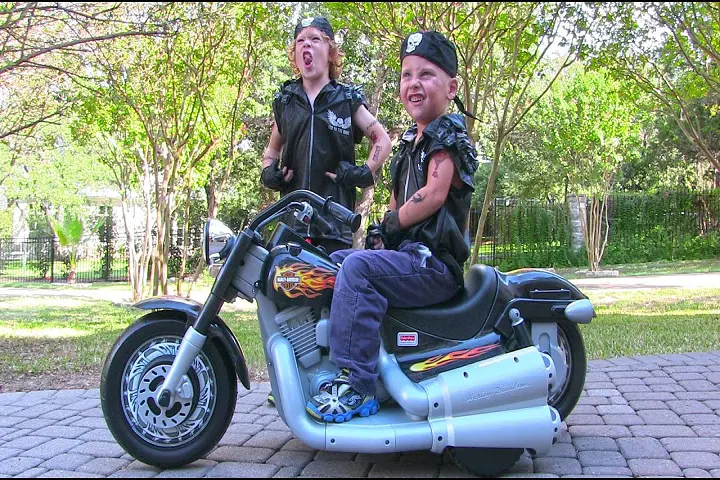
When it comes to kids’ motorcycles, one size doesn’t fit all. The market offers a variety of options to suit different ages, skill levels, and preferences.
Electric vs. Gas-Powered: Pros and Cons
| Feature | Electric | Gas-Powered |
| Noise Level | Quiet | Louder |
| Maintenance | Low | Higher |
| Power | Instant torque | More powerful |
| Range | Limited by battery | Longer with refueling |
| Environmental Impact | Lower emissions | Higher emissions |
| Cost | Higher upfront, lower long-term | Lower upfront, higher long-term |
| Weight | Generally lighter | Heavier |
| Learning Curve | Easier for beginners | Steeper learning curve |
| Customization | Limited | More options available |
The choice between electric and gas-powered motorcycles often comes down to the child’s age, riding location, and your family’s preferences.
Electric bikes are gaining popularity due to their ease of use and eco-friendly nature, while gas-powered bikes offer a more traditional riding experience and are often preferred for competitive riding.
Age-Appropriate Options
Balance Bikes for Toddlers (2-4 years)
- No pedals or motor
- Teaches balance and steering
- Low to the ground for safety
- Examples: Strider 12 Sport, KaZAM Classic Balance Bike
- Benefits: Develops core strength and spatial awareness
- Transition: Excellent precursor to pedal bikes and motorized options
Balance bikes are an excellent starting point for the youngest riders. They help children develop the fundamental skills needed for all types of cycling and motorcycling.
Training Wheels for Beginners (4-6 years)
- Pedal-powered or small electric motors
- Removable training wheels
- Low-speed settings
- Examples: Razor MX350 Dirt Rocket, Yamaha PW50
- Safety features: Speed limiters, easy-to-reach controls
- Skill development: Introduces throttle and brake control
These bikes bridge the gap between balance bikes and full-fledged motorcycles. They allow children to get comfortable with the concept of powered movement while still providing stability.
Small Displacement Bikes for Older Kids (7+)
- Gas-powered or more powerful electric motors
- Suitable for off-road use
- Adjustable speed settings
- Examples: KTM 50 SX, Honda CRF50F
- Advanced features: Suspension systems, multiple gears
- Riding environments: Designed for varied terrain including motocross tracks
As children grow and their skills improve, these bikes offer a more authentic motorcycling experience. They’re often used in competitive settings and can be a stepping stone to adult-sized motorcycles.
Key Features to Look For
When shopping for a kids’ motorcycle, certain features can make all the difference in safety and enjoyment.
Adjustable Speed Limiters
A crucial safety feature, speed limiters allow parents to set maximum speeds based on their child’s skill level. Look for:
- Easy-to-use adjustment mechanisms
- Multiple speed settings
- Tamper-resistant designs
- Gradual increase options
- Remote control capabilities (on some advanced models)
Speed limiters are invaluable for tailoring the bike’s performance to your child’s growing abilities. They provide peace of mind for parents while allowing children to push their boundaries safely.
Sturdy Construction and Durable Materials
Kids can be tough on their toys, so durability is key. Prioritize:
- Steel frames for stability
- High-quality plastics for fairings
- Reinforced wheels and tires
- Rust-resistant components
- Shock-absorbing materials
- Easy-to-replace parts
Durability isn’t just about longevity; it’s a safety feature. A well-constructed bike is less likely to fail during use, reducing the risk of accidents.
Easy-to-Use Controls
Simple, intuitive controls help kids focus on riding safely. Check for:
- Twist-grip throttles for smooth acceleration
- Easy-reach brake levers
- Kill switches for quick stops
- Clear, visible gauges or displays
- Ergonomic handlebar design
- Adjustable levers to fit small hands
The easier the controls are to use, the more your child can focus on developing proper riding technique and awareness of their surroundings.
Comfortable Seating and Ergonomics
Long rides require comfort. Look for:
- Padded seats with good support
- Adjustable handlebars for growing riders
- Footpegs positioned for easy reach
- Suspension systems to absorb bumps
- Vibration-dampening grips
- Adjustable seat height options
Comfort isn’t just about luxury; it’s about safety. A comfortable rider is less likely to become fatigued and can maintain better control of the bike.
Top Brands in the Kids’ Motorcycle Market
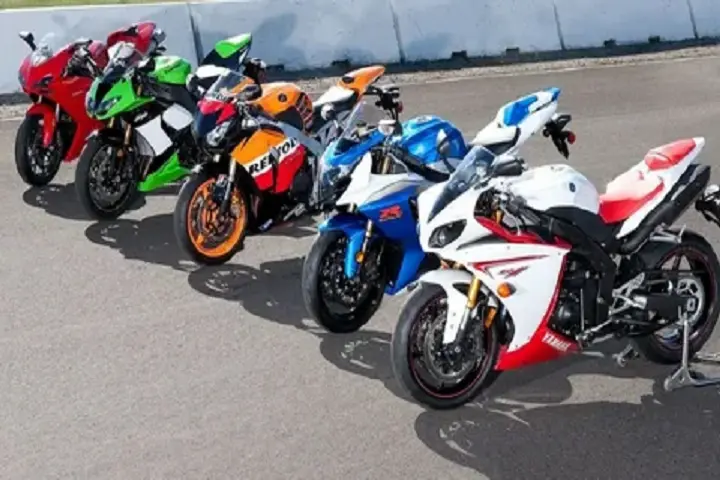
Several manufacturers have made a name for themselves in the kids’ motorcycle arena. Let’s explore some top contenders:
Razor: Electric Options for Younger Riders
Razor has become synonymous with kids’ electric vehicles. Their motorcycles offer:
- Quiet, eco-friendly operation
- Safety-focused designs
- Affordable price points
- User-friendly controls
- Low maintenance requirements
- Range of models for different ages
Popular model: Razor MX650 Rocket Electric Motocross Bike
Key features:
- 17 mph top speed
- 40 minutes of continuous use
- Dual suspension system
- Steel frame construction
- Pneumatic knobby tires
Razor’s focus on electric motorcycles makes them an excellent choice for families looking for a low-maintenance, environmentally friendly option.
KTM: Performance-Oriented Dirt Bikes
Known for their off-road prowess, KTM’s kids’ line doesn’t disappoint:
- High-quality components
- Powerful engines
- Advanced suspension systems
- Race-inspired designs
- Lightweight construction
- Extensive customization options
Popular model: KTM 50 SX
Key features:
- 49cc two-stroke engine
- Automatic clutch
- Adjustable power valve
- Hydraulic disc brakes
- WP XACT suspension
KTM’s bikes are often favored by families involved in competitive riding, offering performance that can grow with the child’s skills.
Honda: Reliable and Versatile Choices
Honda’s reputation for reliability extends to their kids’ motorcycles:
- Durable construction
- User-friendly features
- Extensive dealer network for support
- Wide range of models
- Excellent resale value
- Progressive learning designs
Popular model: Honda CRF110F
Key features:
- 109cc air-cooled engine
- Four-speed transmission with automatic clutch
- Adjustable throttle limiter
- Low seat height
- Electric start with kick-start backup
Honda’s bikes are known for their versatility, suitable for both casual trail riding and more serious off-road adventures.
Yamaha: Balance of Power and Safety Features
Yamaha offers a range of options that grow with your child:
- Models for various skill levels
- Innovative safety technologies
- Smooth power delivery
- Ergonomic designs
- Fuel efficiency
- Robust build quality
Popular model: Yamaha TT-R50E
Key features:
- 49cc air-cooled engine
- Three-speed automatic transmission
- Seat height of just 21.9 inches
- Electric start
- Adjustable throttle stop screw
Yamaha’s attention to safety features and ergonomics makes their bikes popular choices for parents introducing their children to motorcycling.
Safety Gear: Non-Negotiables

No discussion of kids’ motorcycles is complete without addressing safety gear. Proper equipment is crucial for protecting young riders.
Helmets: Fit and Features to Prioritize
A well-fitting helmet is the most important piece of safety gear. Look for:
- DOT or Snell certification
- Proper size and snug fit
- Good ventilation
- Bright colors for visibility
- Impact-absorbing liner
- Secure chinstrap
- Face shield or goggle compatibility
Pro tip: Replace helmets after any significant impact or every 3-5 years.
Choosing the right helmet is critical. It should fit snugly without any pressure points, and the child should be involved in the selection process to ensure they’re comfortable wearing it.
Protective Clothing: Jackets, Pants, and Gloves
Riding gear should cover all exposed skin:
- Abrasion-resistant materials like Kevlar or leather
- Padding in key impact areas (elbows, shoulders, knees)
- Gloves with reinforced palms and knuckles
- Reflective elements for visibility
- Breathable fabrics for comfort
- Adjustable fit to accommodate growth
- Weather-appropriate options
Proper clothing not only protects in case of a fall but also shields the rider from debris and weather conditions.
Boots: Ankle Support and Grip
Proper footwear is often overlooked but crucial:
- Over-the-ankle height for support
- Oil-resistant soles for grip
- Reinforced toe boxes
- Secure closures (buckles or laces)
- Water-resistant materials
- Breathable linings
- Reflective elements
Motorcycle-specific boots provide the necessary protection and control that regular shoes can’t match.
Eye Protection: Goggles or Face Shields
Protect those young eyes from debris and wind:
- Impact-resistant lenses
- Anti-fog coatings
- Secure, comfortable fit
- UV protection
- Tear-off compatibility for muddy conditions
- Wide peripheral vision
- Adjustable straps
Clear vision is essential for safe riding. Ensure your child’s eye protection is always clean and scratch-free.
Teaching Kids to Ride: A Step-by-Step Approach
Now that we’ve covered the equipment, let’s focus on getting kids rolling safely.
Starting with Basics: Balance and Coordination
Begin with these foundational skills:
- Practice on a balance bike or bicycle first
- Teach proper posture and grip
- Start on flat, open areas away from traffic
- Focus on looking ahead, not down
- Encourage smooth, controlled movements
- Practice getting on and off the bike safely
- Teach proper foot placement on pegs or pedals
Building a strong foundation of balance and coordination will make the transition to a powered motorcycle much smoother.
Mastering Controls: Throttle, Brakes, and Steering
Once balance is achieved, introduce:
- Gentle throttle control
- Proper braking technique (both front and rear)
- Smooth steering inputs
- Clutch control (for manual transmission bikes)
- Shifting gears (when applicable)
- Emergency stop procedures
- Proper body positioning for turns
Take time to explain how each control works and how they work together. Use analogies that children can understand to explain concepts like traction and momentum.
Practice Drills for Skill Development
Set up simple exercises to build confidence:
- Slow-speed maneuvering around cones
- Straight-line riding with controlled stops
- Gradual turns and figure-eights
- Riding over small obstacles
- Starting and stopping on inclines
- Emergency swerving techniques
- Riding in various weather conditions (when appropriate)
Regular practice sessions with specific goals will help your child improve their skills systematically.
Graduating to More Challenging Terrain
As skills improve, introduce:
- Slight inclines and declines
- Basic off-road surfaces (grass, packed dirt)
- Longer rides to build endurance
- Simple jumps and bumps
- Varied terrain navigation
- Group riding etiquette
- Basic racing techniques (if interested in competition)
Always ensure the terrain matches your child’s skill level, and never push them beyond their comfort zone too quickly.
“The only way to learn to ride a motorcycle is to get on one and ride it.” – Keith Code
This quote from renowned motorcycle instructor Keith Code emphasizes the importance of hands-on experience. While theory and instruction are important, nothing beats actual riding time for developing skills.
Maintenance Matters: Keeping the Bike in Top Shape
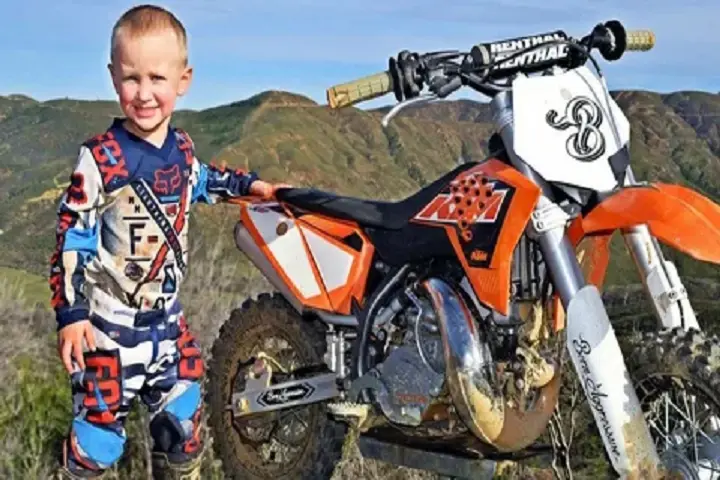
A well-maintained motorcycle is a safer motorcycle. Teach your child the importance of regular upkeep.
Regular Safety Checks
Before each ride, check:
- Tire pressure and condition
- Brake function
- Chain tension (if applicable)
- All fasteners and controls
- Fuel level (for gas-powered bikes)
- Battery charge (for electric bikes)
- Lights and signals (if equipped)
- Suspension operation
Involving your child in these checks teaches responsibility and mechanical awareness.
Cleaning and Lubrication Tips
After riding:
- Wash the bike with mild soap and water
- Dry thoroughly to prevent rust
- Lubricate chain and moving parts as needed
- Check and clean air filter (especially for off-road use)
- Inspect for any loose or damaged parts
- Clean and lubricate control cables
- Treat any exposed metal with anti-corrosion spray
Regular cleaning not only keeps the bike looking good but also provides an opportunity to inspect for any potential issues.
When to Seek Professional Servicing
While many maintenance tasks can be done at home, some require expert attention:
- Annual tune-ups
- Engine or electrical issues
- Suspension adjustments
- Major repairs or upgrades
- Tire changes
- Brake system bleeding
- Valve adjustments (for four-stroke engines)
Establishing a relationship with a reputable motorcycle shop can be invaluable for keeping your child’s bike in top condition.
Legal Considerations and Riding Areas
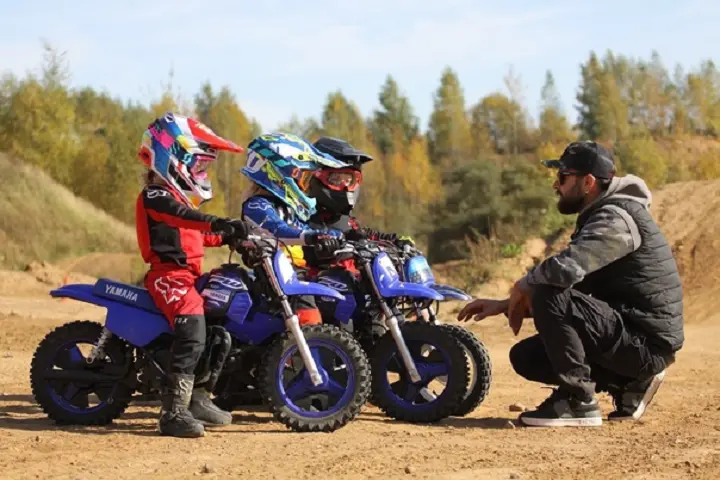
Understanding the legal landscape is crucial for responsible motorcycle ownership.
Age Restrictions and Licensing Requirements
Rules vary by location, but generally:
- Most areas require a minimum age for public road use
- Off-road use may have different age restrictions
- Some regions require safety courses or certifications
Always check local laws before allowing your child to ride.
Where to Ride: Tracks, Trails, and Private Property
Safe riding areas include:
- Designated off-road vehicle parks
- Private tracks or motocross facilities
- Large private properties (with permission)
Avoid:
- Public roads
- Crowded areas
- Environmentally sensitive locations
Insurance and Liability Concerns
Consider:
- Adding the motorcycle to your homeowner’s or renter’s insurance
- Specific off-road vehicle insurance policies
- Liability coverage for potential accidents
The Benefits Beyond the Ride
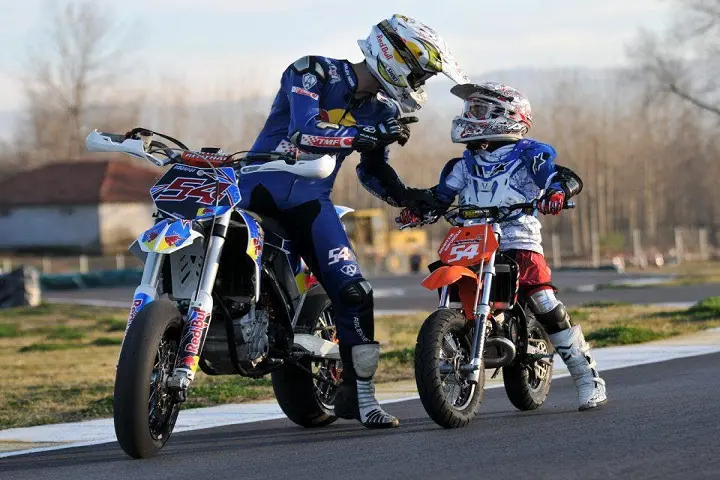
Kids’ motorcycles offer more than just fun – they can be valuable tools for personal development.
Building Confidence and Self-Reliance
Mastering a motorcycle helps children:
- Overcome fears
- Set and achieve goals
- Develop problem-solving skills
Developing Motor Skills and Spatial Awareness
Riding enhances:
- Hand-eye coordination
- Balance and proprioception
- Reaction times
Fostering a Sense of Responsibility
Owning a motorcycle teaches:
- Equipment care and maintenance
- Safety consciousness
- Respect for rules and boundaries
Family Bonding Through Shared Experiences
Motorcycling can become a family activity:
- Shared rides and adventures
- Working on bikes together
- Attending events or races
Environmental Impact and Future Trends

As we look to the future of kids’ motorcycles, several trends are emerging:
The Shift Towards Electric: Quieter, Cleaner Rides
Electric motorcycles are gaining popularity due to:
- Reduced noise pollution
- Zero direct emissions
- Lower operating costs
Sustainable Materials in Manufacturing
Manufacturers are exploring:
- Recycled plastics for body panels
- Bio-based lubricants
- More efficient production processes
Smart Features: GPS Tracking and Parental Controls
New technologies offer:
- Real-time location tracking
- Remote speed limiting
- Usage statistics for monitoring riding habits
Conclusion: Nurturing a Lifelong Passion
Kids’ motorcycles offer a unique blend of excitement, skill-building, and family bonding. By prioritizing safety, choosing the right equipment, and fostering responsible riding habits, parents can help their children develop a lifelong passion for two-wheeled adventures.
Remember:
- Start with age-appropriate bikes
- Invest in quality safety gear
- Teach proper techniques and maintenance
- Supervise and support your young rider’s journey
With the right approach, a kids’ motorcycle can be more than just a toy – it can be a vehicle for growth, confidence, and unforgettable memories.
So, are you ready to kickstart your child’s motorcycling adventure? The open road (or trail) awaits!

With over 5 years of dedicated experience in the automotive industry, I am passionate about all things automotive. My journey began with a deep curiosity for automobiles, which led me to delve deeper into their mechanics, technology and trends. My expertise spans various aspects of the automotive world, from the latest electric vehicles to classic car restoration techniques. Through my articles, I aim to share my knowledge and insights, helping readers stay informed and inspired in the fast-paced world of the automobile.











